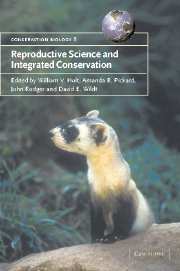Book contents
- Frontmatter
- Contents
- List of contributors
- Foreword
- Part I Introduction
- Part II Reproduction and population viability
- 2 Behaviour and reproduction
- 3 Nutrition and its interaction with reproductive processes
- 4 Environmental chemicals and the threat to male fertility in mammals: evidence and perspective
- 5 Assessing the consequences of inbreeding for population fitness: past challenges and future prospects
- 6 Impacts of inbreeding on components of reproductive success
- 7 The major histocompatibility complex (MHC) in declining populations: an example of adaptive variation
- 8 When is the birth rate the key factor associated with population dynamics?
- Part III Reproductive techniques for conservation management
- Part IV Integrated conservation management
- Part V Reproduction science in non-mammalian species
- Part VI Conclusions
- Index
- References
6 - Impacts of inbreeding on components of reproductive success
Published online by Cambridge University Press: 21 January 2010
- Frontmatter
- Contents
- List of contributors
- Foreword
- Part I Introduction
- Part II Reproduction and population viability
- 2 Behaviour and reproduction
- 3 Nutrition and its interaction with reproductive processes
- 4 Environmental chemicals and the threat to male fertility in mammals: evidence and perspective
- 5 Assessing the consequences of inbreeding for population fitness: past challenges and future prospects
- 6 Impacts of inbreeding on components of reproductive success
- 7 The major histocompatibility complex (MHC) in declining populations: an example of adaptive variation
- 8 When is the birth rate the key factor associated with population dynamics?
- Part III Reproductive techniques for conservation management
- Part IV Integrated conservation management
- Part V Reproduction science in non-mammalian species
- Part VI Conclusions
- Index
- References
Summary
INTRODUCTION AND OBJECTIVES
Although inbreeding depression may reduce individual fitness at all life-history stages, empirical investigations have been largely limited to studies of juvenile survival in captive mammals. Numerous studies (e.g. Ralls et al., 1979; Ballou & Ralls, 1982; Ralls & Ballou, 1982; Ralls et al., 1988; Lacy et al., 1993, reviewed by Thornhill, 1993) have demonstrated a reduction in the survival of offspring produced by related mates. This narrow focus, however, has led some scientists (e.g. Shields, 1982) to speculate that inbreeding depression is less important than it appears from the size of the effects found. First, if some offspring will usually be lost due to sib–sib competition, losses due to inbreeding depression may not drastically affect the parent's fitness. Second, it is possible (but still largely untested) that inbreeding could result in enhancements to other components of fitness, thereby offsetting reductions in juvenile survival.
It is not clear, however, that inbreeding depression affects mainly juvenile life-history traits (Charlesworth & Charlesworth, 1987). Rather, the effects of inbreeding on early stages of reproduction and other adult life-history traits have been little investigated, especially in non-domesticated animals. Inbred individuals that survive to adulthood may still suffer reduced fitness via reduced adult survival, poor performance in mating competition, reduced fecundity and less capable parental care. The paucity of data regarding the effect of inbreeding on these adult traits may lead biologists to underestimate the total cost of inbreeding for sexually reproducing species.
- Type
- Chapter
- Information
- Reproductive Science and Integrated Conservation , pp. 82 - 96Publisher: Cambridge University PressPrint publication year: 2002
References
- 3
- Cited by



